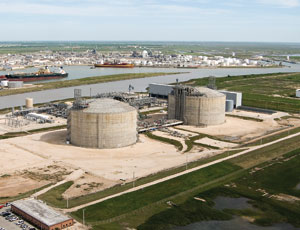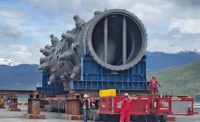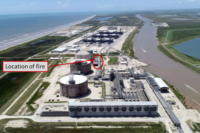The sudden abundance of natural gas in the U.S. has owners of two new, but practically unused, liquefied natural gas (LNG) import terminals in Louisiana and Texas proposing expensive conversions to export the fuel—an unthinkable proposition just five years ago.

Freeport LNG and Cheniere Energy Inc., both of Houston, have announced separate plans to convert their existing LNG import terminals into export-import terminals, plans that would cost each company about $2 billion. The firms each anticipate approval from the U.S. Energy Dept. and the Federal Energy Regulatory Commission by about 2012, when they would begin facility construction, and both plan to begin exporting LNG by 2015.
In Demand
“There have been significant changes in the amount of natural gas since we initially started the construction end of this project,” says Charles Reimer, president of Freeport LNG. He refers to the time when the company began to build its $1-billion import facility on Quintana Island in Freeport, Texas, in 2003. That facility, about 70 miles south of Houston, along with Cheniere's Sabine Pass terminal, along the Texas-Louisiana border in Cameron Parish, La., were completed in 2008 to help feed a growing need for natural gas in the U.S. that could not be met domestically.
But before the terminals were completed, advances in horizontal drilling and hydraulic fracturing allowed natural gas from the nation's shale formations to begin supplying U.S. demand. Since the Freeport terminal began operation in 2008, it has not received a single shipment for import. Instead, it has been receiving and storing natural gas for re-export elsewhere.
The amount of recoverable natural gas in the U.S. jumped from an estimated 347 trillion cu ft in 2010 to 827 trillion cu ft in 2011, according to the U.S. Energy Information Administration. The U.S. now has enough natural gas for 100 years, according to officials at Freeport.
The market for that gas, which is large in developing countries, is poised to be even greater because of the March 11 disaster at Japan's Fukushima Daiichi nuclear plant. The country is temporarily relying on LNG imports for some additional power. Europe, meanwhile, is discussing shutting down some of its nuclear plants.
The Freeport facility would consist of two sites separated by about 10 miles. One site, north of Quintana, would be used to treat the natural gas piped to the facility to remove nitrogen, water, hydrogen sulfide, carbon dioxide and other components in natural gas that would freeze when liquefied. The gas would then be piped by a 42-in. pipeline to Quintana where four 100,000-hp compressors and other cooling equipment would liquefy the gas to -260� F—a state that allows the natural gas to be easily stored or moved. The LNG would be stored on site and shipped from the terminal on Quintana Island. The expanded facility could liquefy up to 1.4 billion cu ft per day (bcf/d) of natural gas.
The site would retain the ability to import, or regasify, LNG, but some equipment, such as cooling fans that were originally built for regasification, would be used to cool, rather than warm the gas, Reimer says. Freeport is using about one-third to one-half of its 200 acres under long-term lease with existing equipment, he adds.
According to Nick O'Kane, global head of energy markets for Houston-based Macquarie Cook Energy LLC, a division of the Macquarie Group, Freeport is in an ideal spot for exports because it is close to Barnett Shale in northwestern Texas and to Eagleford Shale to the south and the west. Macquarie is the fourth-largest U.S. trader of natural gas.
Partnership
Macquarie and Freeport have entered into a partnership to develop and market the LNG export terminal. While those entities are supplying some seed money to get the project off the ground, they expect to seek market financing for the project once they have contracts to liquefy the natural gas and to export it. Reimer says that Freeport is paying its financing on the first portion of the plant through funds received from storage of LNG for re-export.
Reimer also says that Freeport has contacted the engineer-procure-construct consortium of Technip USA, Zachry Construction of San Antonio and Saipem SpA of Italy, which built its import terminal. But no bid proposals for the facility have yet been requested.
Long-Term Risk?
Cheniere has selected San Francisco-based Bechtel Group, which built its gasification plant, to construct the liquefaction facility. Cheniere plans to build up to four liquefaction trains on its existing 853-acre site in Cameron Parish, La. Each train would liquefy up to 500 million cu ft per day, with the potential to liquefy up to 2 bcf/d. The initial project would consist of two trains, according to the company. Cheniere has already signed memorandums of understanding to sell LNG to companies in Japan, Spain and the Dominican Republic.
Despite the ample supply and demand, approval of the two U.S. export plants is not guaranteed. Industrial customers have complained to FERC that exporting natural gas is not in the country's best interest and would raise the price of natural gas. Freeport and Cheniere say that the export of natural gas would raise prices only marginally.
Officials with Overland Park, Kan.-based Black & Veatch, which develops LNG plants in other markets, say that the export of U.S. natural gas is a long-term risk that it isn't willing to take. “Those projects have a long, long way to go,” says Brian Price, vice president and LNG technology manager. “We're probably talking years and political battles.”
Article toolbar


Post a comment to this article
Report Abusive Comment